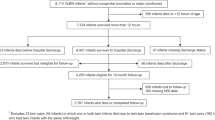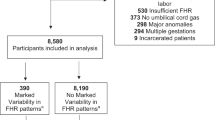Abstract
OBJECTIVE: To determine retrospectively mean arterial pressure (MAP) for stable and unstable concordant and discordant very low birth weight (VLBW: 801 to 1500 g) twins during the first 24 hours of life.
BACKGROUND: Morbidity and mortality are much higher for extremely low birth weight (ELBW ≤800 g) than for VLBW twins. Recently, we reported MAP trends and reference values in concordant and discordant ELBW twins. No comparable information is available for VLBW infants.
DESIGN: Retrospective cohort study.
METHODS: We studied 48 sets of concordant and 40 sets of discordant (birth weight difference ≥20%) consecutively born VLBW twins. Stable patients were defined as having umbilical cord hemoglobin ≥14 g/dl, nonacidotic blood gases, never treated for hypotension and survived at least 7 days. MAPs (Torr) were measured by oscillometry in 3163 and by transducer via umbilical artery in 2028 instances.
RESULTS: Concordant and discordant twins were similar in demographics, history of twin–twin transfusion (TTTX), antenatal steroids, chorioamnionitis, pre-eclampsia, cesarean delivery, cord hemoglobin, normal head ultrasounds or I to II intracranial hemorrhage (97 and 99%) and neonatal mortality (4 and 5%), but were different in incidence of preterm labor (83 and 58%), birth weight (1227 and 1509 g) and gestational age (GA) (30 and 32 weeks). In all, 66 (69%) concordant twins and 61 (76%) discordant twins were stable. Stable concordant twins, whether small or large, had comparable MAP on admission that increased to 24 hours. Twins of ≤32 weeks GA had lower MAP throughout than those of ≥33 weeks GA. Although their mean birth weights were similar (1262 and 1274 g), 23 stable concordant males had significantly higher MAP than 43 concordant females. Stable discordant twins were divided into 31 small (1241 g) and 30 large (1845 g); their MAPs were different (p<0.05): 35 and 39 (admission), 35 and 39 (1 hour), 36 and 46 (6 hours), 38 and 41 (12 hours), 40 and 41 (18 hours) and 42 and 42 (24 hours) Torr. In all, 88% of small discordant twins were IUGR and 91% of large discordant twins had normal growth. TTTX syndrome occurred in 12 monochorionic sets. Nine of 12 donors were IUGR while 10 of 12 recipients had normal growth. Four of 12 donors had grades III to IV intracranial hemorrhage, eight donors and all 12 recipients had normal ultrasounds. Although their cord hemoglobin levels were similar, donor and recipient MAPs were higher than in any other group and, opposite to concordant and discordant twins, their values decreased from birth to 24 hours.
CONCLUSION: In stable concordant, stable discordant, and small and large discordant twins, MAP correlates with birth weight, GA and postnatal age, and increases during the first 24 hours. In recipient and donor twin–twin transfusion infants, MAP is higher throughout and declines over time.
This is a preview of subscription content, access via your institution
Access options
Subscribe to this journal
Receive 12 print issues and online access
$259.00 per year
only $21.58 per issue
Buy this article
- Purchase on Springer Link
- Instant access to full article PDF
Prices may be subject to local taxes which are calculated during checkout



Similar content being viewed by others
References
Tyson JE, Younes J, Verter J, Wright LL . Viability, morbidity, and resource use among newborns of 501–800-g birth weight. JAMA 1996;276:1645–1651.
Sonntag J, Waltz S, Schollmeyer T, Schüppler U, Schröder H, Weisner D . Morbidity and mortality of discordant twins up to 34 weeks of gestational age. Eur J Pediatr 1996;155:224–229.
Hollier LM, McIntire DD, Leveno KJ . Outcome of twin pregnancies according to intrapair birth weight differences. Obstet Gynecol 1999;94:1006–1010.
Denbow ML, Battin MR, Cowan F, Azzopardi D, Edwards AD, Fisk NM . Neonatal cranial ultrasonographic findings in preterm twins complicated by severe fetofetal transfusion syndrome. Am J Obstet Gynecol 1998;178:479–483.
Rizzo G, Arduini D, Romanini C . Cardiac and extracardiac flows in discordant twins. Am J Obstet Gynecol 1994;170:1321–1327.
Zosmer N, Bajoria R, Weiner E, Rigby M, Vaughan J, Fisk NM . Clinical and echographic features of in utero cardiac dysfunction in the recipient twin in twin–twin transfusion syndrome. Br Heart J 1994;72:74–79.
Miall-Allen VM, de Vries LS, Dubowitz LMS, Whitelaw AGL . Blood pressure fluctuation and intraventricular hemorrhage in the preterm infant of less than 31 weeks' gestation. Pediatrics 1989;83:657–661.
Watkins AMC, West CR, Cooke RWI . Blood pressure and cerebral haemorrhage and ischaemia in very low birthweight infants. Early Hum Dev 1989;19:103–110.
Bada HS, Korones SB, Perry EH, et al. Mean arterial blood pressure changes in premature infants and those at risk for intraventricular hemorrhage. J Pediatr 1990;117:607–614.
Low JA, Froese AB, Galbraith RS, Smith JT, Sauerbrei EE, Derrick EJ . The association between preterm newborn hypotension and hypoxemia and outcome during the first year. Acta Paediatr 1993;82:433–437.
Cunningham S, Symon AG, Elton RA, Zhu C, McIntosh N . Intra-arterial blood pressure reference ranges, death and morbidity in very low birthweight infants during the first seven days of life. Early Hum Dev 1999;56:151–165.
Gill AB, Weindling AM . Echocardiographic assessment of cardiac function in shocked very low birthweight infants. Arch Dis Child 1993;68:17–21.
Seri I, Evans J . Controversies in the diagnosis and management of hypotension in the newborn infant. Curr Opin Pediatr 2001;13:116–123.
Cordero L, Timan CJ, Waters HH, Sachs LA . Mean arterial pressures during the first 24 hours of life in ≤600 gram birth weight infants. J Perinatol 2002;22:348–353.
Al-Aweel I, Pursley DM, Rubin LP, Shah B, Weisberger S, Richardson DK . Variations in prevalence of hypotension, hypertension, and vasopressor use in NICUs. J Perinatol 2001;21:272–278.
Cordero L, Johnson JR . Mean arterial pressure in extremely low birth weight concordant and discordant twins during the first day of life. J Perinatol 2002;22:526–534.
Victoria A, Mora G, Arias F . Perinatal outcome, placental pathology, and severity of discordance in monochorionic and dichorionic twins. Obstet Gynecol 2001;97:310–315.
Sherer DM . Adverse perinatal outcome of twin pregnancies according to chorionicity: review of the literature. Am J Perinatol 2001;181:23–37.
Quintero RA, Morales WJ, Allen MH, Bornick PW, Johnson PK, Kruger M . Staging of twin–twin transfusion syndrome. J Perinatol 1999;19:550–555.
Ananth CV, Vintzileos AM, Shen-Schwarz S, Smulian JC, Lai YL . Standards of birth weight in twin gestations stratified by placental chorionicity. Obstet Gynecol 1998;91:917–924.
Papile LA, Burstein J, Burstein R, Koffler H . Incidence and evolution of the subependymal intraventricular hemorrhage: a study of infants with weights less than 1500 g. J Pediatr 1978;92:529–534.
Nuntnarumit P, Yang W, Bada-Ellzey HS . Blood pressure measurements in the newborn. Clin Perinatol 1999;26:981–996.
Versmold HT, Kitterman JA, Phibbs RH, Gregory GA, Tooley WH . Aortic blood pressure during the first 12 hours of life in infants with birth weight 610 to 4,220 grams. Pediatrics 1981;67:607–613.
Moscoso P, Goldberg RN, Jamieson J, Bancalari E . Spontaneous elevation in arterial blood pressure during the first hours of life in the very-low-birth-weight infant. J Pediatr 1983;103:114–117.
Park MK, Menard SM . Accuracy of blood pressure measurement by the Dinamap monitor in infants and children. Pediatrics 1987;79:907–914.
Spinazzola RM, Harper RG, de Soler M, Lesser M . Blood pressure values in 500- to 750-gram birthweight infants in the first week of life. J Perinatol 1991;11:147–151.
Hegyi T, Carbone MT, Anwar J, et al. Blood pressure ranges in premature infants: 1. The first hours of life. J Pediatr 1994;124:627–633.
Evans N, Moorcraft J . Effect of patency of the ductus arteriosus on blood pressure in very preterm infants. Arch Dis Child 1992;67:1169–1173.
Zubrow AB, Hulman S, Kushner H, Falkner B . Determinants of blood pressure in infants admitted to neonatal intensive care units: a prospective multicenter study. J Perinatol 1995;15:470–479.
Lee J, Rajadurai VS, Tan KW . Blood pressure standards for very low birthweight infants during the first day of life. Arch Dis Child 1999;81:F168–F170.
Laratza AA, Wolfenden JL, Taylor MJO, Wee L, Fisk NM, Gardiner HM . Influence of twin–twin transfusion syndrome on fetal cardiovascular structure and function: prospective case–control study of 136 monochorionic twin pregnancies. Heart 2002;88:271–277.
Cheung YF, Taylor MJO, Fisk NM, Redington AN, Gardiner HM . Fetal origins of reduced arterial distensibility in the donor twin in twin–twin transfusion syndrome. Lancet 2000;355:1157–1158.
Bajoria R, Sullivan M, Fisk NM . Endothelin an association with cardiac dysfunction in the recipient fetus of twin–twin transfusion syndrome. Hum Reprod 1999;14:1614–1618.
Bajoria R, Sooranna SR . Elevated renin–angiotensin levels in the recipient twin of severe twin–twin transfusion syndrome with neonatal hypertension. Placenta 1999;20:A13.
Martyn CN, Barker DJP, Jespersen S, Greenwald S, Osmond C, Berry C . Growth in utero, adult blood pressure, and arterial compliance. Br Heart J 1995;73:116–121.
Simpson LL, Marx GR, Elkadry EA, D'Alton ME . Cardiac dysfunction in twin–twin transfusion syndrome: a prospective, longitudinal study. Obstet Gynecol 1998;92:557–562.
Tolosa EJ, Zoppini C, Ludomirsky A, Bhuthani V, Weil SR, Huhta JC . Fetal hypertension and cardiac hypertrophy in the discordant twin syndrome. Am J Obstet Gynecol 1993;168:A292.
Fesslova V, Villa L, Nava S, Mosca Fabio, Nicolini U . Fetal and neonatal echocardiographic findings in twin–twin transfusion syndrome. Am J Obstet Gynecol 1998;179:1056–1062.
Baud O, Lebidois J, Van Peborgh P, Ville Y . Fetal and neonatal hypertension in twin–twin transfusion syndrome: a case report. Fetal Diagn Ther 1998;13:223–226.
Mahieu-Caputo D, Dommergues M, Delezoide AL, et al. Twin-to-twin transfusion syndrome: role of the fetal renin–angiotensin system. Am J Pathol 2000;156:629–636.
Acknowledgements
We would like to acknowledge Larry A. Sachs, PhD for his assistance with statistical analysis.
Author information
Authors and Affiliations
Rights and permissions
About this article
Cite this article
Cordero, L., Giannone, P. & Rich, J. Mean Arterial Pressure in Very Low Birth Weight (801 to 1500 g) Concordant and Discordant Twins During the First Day of Life. J Perinatol 23, 545–551 (2003). https://doi.org/10.1038/sj.jp.7210982
Published:
Issue Date:
DOI: https://doi.org/10.1038/sj.jp.7210982
This article is cited by
-
Preeclampsia: effect on newborn blood pressure in the 3 days following preterm birth: a cohort study
Journal of Human Hypertension (2015)
-
Blood pressures in newborns with twin–twin transfusion syndrome
Journal of Perinatology (2011)
-
Early neonatal hypotension in premature infants born to preeclamptic mothers
Journal of Perinatology (2006)
-
Mean Arterial Pressure in Concordant and Discordant Triplets during the First Week of Life
Journal of Perinatology (2005)



